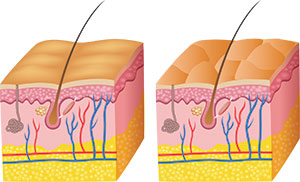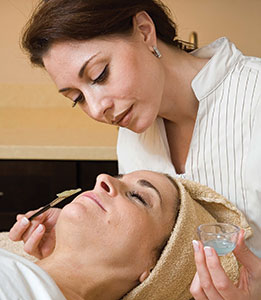10 Things about Compromised Barriers
Written by Robert ManzoThere are many properties of skin, including hydration, sebum content, elasticity, melanin content, and more, which need to be well understood to treat clients properly. Barrier function of the skin is one of the most important properties to understand. Skin hydration and redness (or inflammation) is often dependent on healthy skin barrier function. Here are 10 things to know about skin barrier function.
- What is it? In the most basic terms, barrier function of the skin is a measure of the overall health of the skin. It is the proper arrangement of corneocytes and lipids in the top layer of the skin (stratum corneum) which provides protection from external toxins, while simultaneously preventing excessive loss of moisture from the body. The clinical tool used to measure this property is called a transepidermal water loss measurement (TEWL) probe. An example of this probe is seen below.

- Several different types of acne treatments often lead to barrier impairment due to the aggressive nature of the individual ingredients. These include benzoyl peroxide, salicylic acid, retinoids, antibiotics, and others. These chemicals can erode the lipids in the stratum corneum which can lead to significant dehydration. This can cause the skin to break out more. This is the classic “acne cycle.”
- Sensitivity, redness, and inflammation are common issues with clients. While rare, an impaired barrier can lead directly to skin inflammation and redness due to a biochemical cascade, which starts in the skin to protect it from external toxins. Lipid and barrier repair active ingredients must be used to repair the barrier or the skin will stay in this chronic state of impairment.
- When using alcoholic toners and other products, or employing manual exfoliation techniques, be aware that, if the client’s skin has a tendency to produce oil, these techniques will certainly impair their barrier. The skin will respond to this by producing more oil in an attempt to repair barrier function. This is often called the “rebound effect.”
- When the barrier is impaired, the stratum corneum tends to build up and thicken. This can lead to a rough surface texture on skin due to the corneocytes sticking to the skin surface. Light glycolic peels or a regular exfoliation is important in these cases.
- The tendency in repairing impaired barrier function is to well hydrate the skin. While hydration is important, if the lipid structure in the skin is not repaired, it will not retain the moisture applied to its surface and the skin will dry rapidly. Products which contain a humectant, like glycerin or hyaluronic acid, in combination with an occlusive moisturizer, like dimethicone or petrolatum, will be important when treating an impaired barrier.
- Repairing an impaired barrier can take time. Step one is to create a barrier so the TEWL of the skin stabilizes. This will allow the skin to start to repair itself. This process can take several weeks. It will be important during this period not to treat the skin with active ingredients, as these will generally impair the barrier.
- There are many ingredients that can help stimulate stratum corneum lipid production in the skin – targeted peptides being the most effective. The peptides must be targeted to induce the production of lipids in the epidermis and they need to be bio-available so that the skin can use them properly. Hydration is important as a concurrent treatment.
- Products and ingredients that should not be used during impaired barrier treatment include: alcohol, witch hazel, acids, alkalis, products outside the pH range of 4.5 to 5.5, any peels, microdermabrasion techniques of any kind, and laser treatment.
- Understand the difference between dry and hydrated. A patient may complain about dryness in their skin. Many times, “dryness” means that they are experiencing sebum loss. This happens particularly often in women as they age. The skin can become rigid and less flexible due to the lack of sebum which they interpret as dry. Client may make comments like: “I use a good moisturizer, but my skin is still dry.” Look at the product they are using and assess the ingredients list. If there are good levels of esters, like capric-caprylic triglyceride, then the product will work very well as a sebum supplement and will provide significant relief to the client.
 Understanding what barrier function is, which symptoms to look for, and how to manage symptoms is critical to client care.
Understanding what barrier function is, which symptoms to look for, and how to manage symptoms is critical to client care.
Robert Manzo’s patented and proprietary cosmetic chemistry and product formulations are the result of over 25 years in the skin care development profession. He has conducted clinical research and developed specialized skin care products and techniques in Europe, the United States, South America, and Asia, affording him an expansive knowledge base to achieve personalized solutions for Skinprint’s clients. He has published articles on skin chemistry and the role of antibacterial and anti-inflammatory ingredients on skin, and is a standing member of the Society of Cosmetic Chemists and the American Chemical Society. skinprint.com
